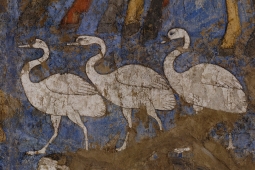Cultural Selection: The Early Maritime Silk Roads and the Emergence of Stone Ornament Workshops in Southeast Asian Port Settlements
© cobalt123/flikrNumerous regions of South and Southeast Asia were directly involved with, and connected by, the maritime Silk Roads at various points in history. In particular, around the beginning of the 1st century CE, a great expansion of international trade occurred, driven by the demand for luxury goods from both Ancient Rome and China. While caravans carried goods relatively slowly along the land routes of the Silk Roads between the Indian Subcontinent and China, ships travelled more rapidly from ports on the Indian sub-continent to Southeast Asia and further East, transporting a wide range of goods that included spices, aromatic woods, resins, and precious gems and stones. Alongside this trade, artists and artisans travelled widely, bringing with them precious works of art and religious objects, which helped to spread artistic traditions and create inter-cultural and religious links across regions. However, archaeological evidence indicates that prior to this 1st century CE expansion, many coastal communities throughout South East Asia engaged in similar, although smaller scale, commercial activities, from perhaps as early as the 4th century BCE.
This early trade was substantive enough to form the basis for the exchange of precious objects and works of art which helped to spread particular styles and influences, skills, and techniques, and create new maritime centres. An excellent example of this was the exchange of stone ornaments and the techniques and styles of stone working, which precipitated the development of ornament workshops in port settlements in parts of what is today Malaysia, Thailand, Cambodia, and Vietnam. In particular, the discovery of stone ornament workshops in port trade centres such as Khao Sam Kaeo on the upper Thai-Malay Peninsula has led to a more nuanced and complex picture of early maritime exchange in the region. Khao Sam Kaeo was one of the earliest of a number of walled maritime settlements that emerged in the 4th century BCE. The settlement was located on the Isthmus of Kra on the Malay Peninsula and exerted control over trans-peninsula routes and served as a marketplace for other nearby maritime settlements. Notably, the city was home to communities of foreign merchants and artisans who resided in areas filled with workshops for gold, silver, carnelian gems stones, and glass jewellery. The layout of the town echoed that found in later maritime Silk Roads entrepots such as Malacca.
Indeed, the import of coloured stones to be worked into jewellery and other small ornaments drove an early rudimentary maritime trade network across Southeast Asia in the final centuries before the beginning of the Common era. Amongst the first stones traded across these relatively large distances were obsidian and nephrite (a type of jade) which have an extensive history of use in China and what is today Vietnam. Some of the most popular wares made from these stones were double headed animal ornaments and ‘lingling-o’ a type of double-headed pendant or amulet associated with various Neolithic and late Iron Age cultures which may have been worn as earrings. These stone ornaments spread across the regions encompassed by the Philippines, the eastern part of Malaysia, Central and Southern Vietnam, Eastern Cambodia, and the peninsula part of Thailand via trade.
Prior to the discovery of workshops in port settlements such as Khao Sam Kaeo, it had been theorised that stone ornaments made of carnelian, agate, jasper, and garnet in Southeast Asia were imported to the region from esteemed workshops in the Indian Subcontinent such as those at Arikamedu where many of the stones originated and where highly skilled artisans had been working for centuries. This hypothesis situated the trade of precious stone ornaments within a broader process of increasing contact with the Indian Subcontinent via the maritime Silk Roads, a significant element of which was the introduction and adoption of Buddhism and Hinduism across Southeast Asia. These items were therefore believed to be a part of this widespread adoption of new influences from India occurring alongside the arrival of priests and merchants to these coastal zones. However, a more complex picture of exchange has emerged, one which highlights the significance of the exchange of ideas, artistic styles, and the movement of people with specific skills, in a complementary fashion to simply the exchange of objects. The discovery of stone working workshops in Southeast Asia coastal trade centres such as Khao Sam Kaeo and others, has indicated that many more of these precious stone objects may actually have been produced locally by foreign artisans rather than imported from the Indian Subcontinent. Over time these workshops will have trained apprentices so that the fine stone working skills used to produce ornaments and jewellery was transferred to Southeast Asia.
Instead of importing ‘wholesale’ styles and influences from the Indian Subcontinent, a distinct regional style in stone working appears to have been established amongst the coastal trading communities which came about via the circulation of skilled artisans and craftspeople across these maritime networks. They worked in local workshops training apprentices in different techniques and styles to create hybridised objects which used resources from other regions of the maritime Silk Roads, were made with techniques circulated via the movement of skilled crafts people, and which reflected a distinct local style with a shared set of artistic and social values embedded in stone ornamentation and jewellery.
See Also

Chinese, Sogdian, and Byzantine Influences on Caftans Uncovered from Archaeological Sites along the Silk Roads
A caftan is a variant, or style, of robe which may be made of wool, cashmere, cotton, or silk and often bound with a sash. It can be worn as a coat or overdress down to the ankles, usually with long sleeves.

Cross-Cultural Influences Reflected in a Bactrian Ewer Depicting Scenes from Ancient Greek Mythology
Sometimes practical and sometimes a piece of decorative art, ewers are tall thin vessels with a wide base, spout, and handle that have been uncovered from numerous archaeological sites from along the lengths of the Silk Roads.






